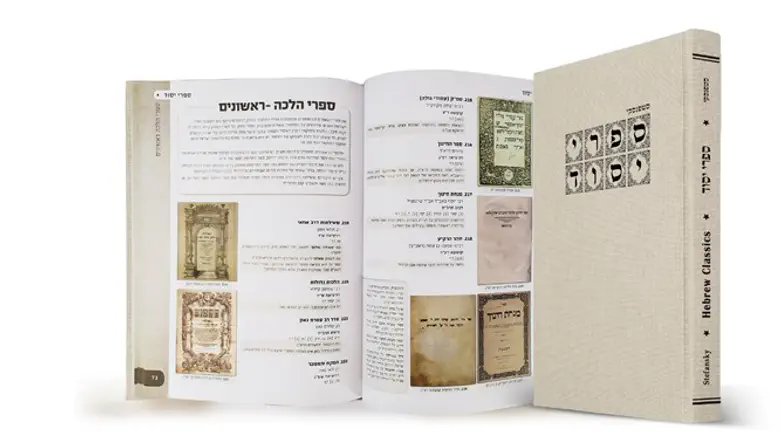
Torah scholars, book collectors and all bibliophiles will welcome a new tool with which to enrich the Torah bookshelf: Sifrei Yesod, (The Guide to Hebrew Classics), compiled by brothers Reb Chaim and Reb Betzalel Stefansky, with the assistance of Rav Isamar Metzger.
Sifrei Yesod is a list of the most fundamental, influential sefarim in the Jewish library: Tanach, Mishnah, Gemara & commentaries, Halachah and rulings, Kabbalah, Chassidus, Medrash, Mussar, hashkafah, as well as siddurim, machzorim, and Haggados. By definition, this is not a comprehensive list of all books ever printed in the above areas of Torah; rather, it includes those works that have withstood the test of time, proven to have had the greatest impact on world Jewry to this day.
Sifrei Yesod is a must for collectors and anyone interested in determining which sefarim are considered all-time Jewish classics, when they were first published, and most importantly, which edition is the most complete and accurate.
One of the most challenging aspects in creating Sifrei Yesod was not in collecting the titles but in choosing which to include and which to leave out. To this end, the Stefansky brothers spared no effort and pored over numerous lists and consulted with talmidei chachamim and academics with the goal of arriving at the most correct decision.
A question that comes up often is how to classify a sefer that most people don't know about today, but which, in previous generations, was studied universally. A prime example is Bechinas Olam, a sefer on mussar and emunah, by the Rishon Yedaya Hapenini, printed at the dawn of Jewish printing. Its overwhelming popularity is underscored by the fact that the greatest gedolei Torah, such as the Tosafos Yom Tov, wrote commentaries on it, and that it was reprinted over one hundred times. Moreover, it had a major impact on many later Mussar sefarim; and yet today, only a handful of scholars are familiar with it. By contrast, many fundamental Rishonim, such as the Ritva and the Meiri, the "bread and butter" in almost every yeshivah, were not available to most Acharonim!
Other questions involve works that were widely influential in one part of the world, but not in others, such as the works of the Maharal – accepted in Ashkenazic communities across Europe but virtually unknown in the Sephardic world — or alternately, sefarim by Rav Chaim Abulafia and Rav Chaim Falaji, basic texts among Sephardim, but with which Ashkenazim had minimal familiarity. Similarly, a certain sefer might have been lionized by one community, while other groups failed to attribute any great importance to it.
The Stefanskys stress that there was no intention whatsoever to belittle any sefer, chas veshalom; rather, the aim was to be judicious and include only those sefarim recognized by the majority of Jewish communities worldwide as having the greatest relevance to the Torah library. That said, they are the first to admit the possibility of having erred in their judgment, and open the discussion to the public.
Sifrei Yesod is organized according to subject, with each title numbered, and easily found in the clearly annotated index at the front. Entries include the name of the sefer, the author, the date and venue of publication, and the general contents as well as a photo of the first-edition title page. Those who lack experience with book collecting may not realize that procuring these photos was the most time-consuming, challenging part of compiling Sifrei Yesod. "We traveled all over the world, to private collectors and libraries," says Reb Chaim Stefansky.
The significance of being able to see the title page cannot be overestimated, as they facilitate identification of the book in question, especially when there are multiple editions, or different works with the same title.
Where applicable, additional information is footnoted at the bottom of the page; for example, additional sefarim written by the same author, or related sefarim written by a different author. Footnotes also feature titles that in their first printing were not printed on their own, but as part of other works. An example would be Iggeres HaRamban, first printed inside the sefer Reishis Chochmah.
Much thought was devoted to the order of the listings, and which almost always appear in the order of their writing as opposed to order of printing. So, for example, in the chapter called "Sifrei Halachah Rishonim," Sefer Rav Amram Gaon appears before Sefer HaRokeach, even though HaRokeach was printed years before Rav Amram Gaon. By the same token, Arbaa Turim was listed in its correct order, even though the volume of "Yoreh Dei'ah" was often printed before "Orach Chaim."
The order of the chapters was established with the intent to enable the reader to progress from chapter to chapter in a logical, sequential manner. Thus, the chapter on the Talmud includes both Rishonim and Acharonim, even though the Acharonim were written many years after the sefarim appearing in the subsequent chapters dedicated to Halachah. Additionally, sifrei Halchah Acharonim were listed before sifrei Halachah Rishonim in order for them to appear near Shulchan Aruch, which appears after the Rif, Rambam, and Tur.
Sifrei Yesod is the culmination of hundreds of hours of painstaking research and fact-checking via private sefarim collections in various points across the globe, university libraries, as well as bibliographies and catalogues. Available at all leading sefarim stores in the US and Canada, Sifrei Yesod is sure to serve as an effective, reliable tool for anyone seeking definitive information on classic Jewish texts.